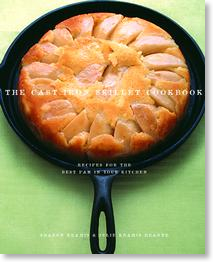Bacon Cooked in a Cast Iron Skillet
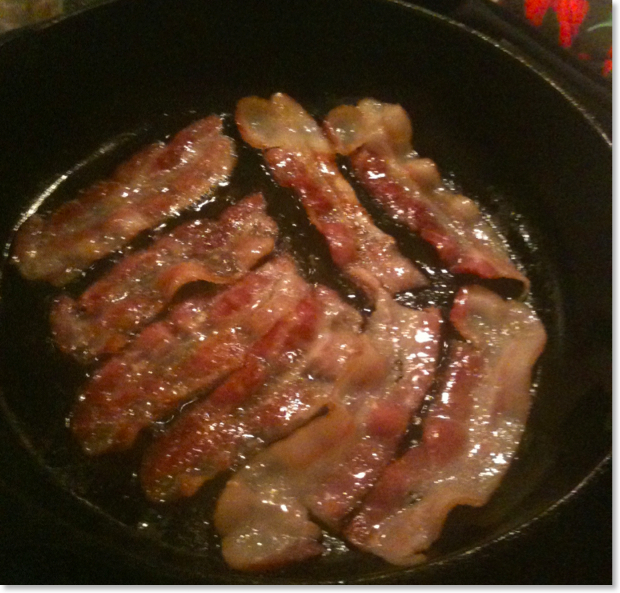
Tip #1: Cut the slices of bacon in half. My mom taught me this trick. She, like I, sometimes became frustrated when bacon slices curled on the ends and as a result cooked unevenly. A friend of Mom’s told her about cutting the bacon slices in two to make them lie flatter in the skillet. Well, it works like a charm! The bacon cooks more quickly and more evenly than full slices.

Tip #2: Use a cast iron press. My husband taught me this trick. I must admit that I don’t use the press as often as he does (frankly I forget), but it certainly makes the bacon lay flat and cook evenly. Even when following Tip #1 above, an occasional slice will curl slightly, depending on the brand. That’s where the cast iron press comes in handy. Rick uses the press on sausage patties, too.
Cast iron pictured above:
Feel free to leave your thoughts in the comments below, or you can contact Kathy directly at kathy@cookingincastiron.com.
Sausage & Asparagus Risotto

My husband and I are fans of Gordon Ramsay’s “Hell’s Kitchen.” Truth be told, the drama and yelling attract me more than any food on the show, but I noticed that risotto was a staple in every single menu served on the show. I didn’t really know what risotto was, much less how to prepare it, so when I came across a sausage and asparagus risotto recipe in a Kroger circular I decided to try it. I’ve modified the recipe slightly and created a low sodium version (since my world now involves doctor-mandated low salt foods). Both versions ended up tasting wonderful, although I would encourage folks to try the “real” version first to get the full experience, especially if you have never tried risotto.
My big “a-ha” was that Arborio rice is made specifically for risotto recipes. Make certain to get this specialty rice so that the risotto turns out the way it should. A trick that seemed to work out well for me was to cook the asparagus in the same skillet that I had browned the sausage. This gave the asparagus a really good flavor, and I had trouble not snacking on the asparagus before it went into the risotto! The original recipe called for 1/2 cup of fresh mushrooms, but I doubled the amount the first time I made it and tripled it the second time, although you could certainly adjust the amount of any of the vegetables to suit your taste.
I used our Lodge 12-inch Pro-Logic skillet, which was the perfect size for the risotto. The sloping sides of this piece of cast iron made the stirring go smoothly—a bonus since the recipe calls for 20 minutes of constant stirring! I used a slanted wooden spatula (pictured), normally used for woks, although any wooden spoon would do.
I loved this recipe so much that I made it twice in three days! Rick definitely liked the regular version the best, but I must admit that the low sodium was more to my liking. Thanks to Gordon Ramsay and “Hell’s Kitchen,” I’m now “in-the-know” about risotto!
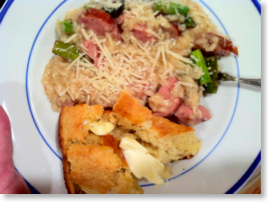
(low sodium options in red)
Cast Iron Required:
12” skillet
Ingredients
- 1 lb. smoked sausage (or half a pound of sausage)
- 4 cups chicken broth (4 tsp. sodium free chicken bouillon w/ 4 cups water)
- 1 Tbsp. olive oil
- 1 onion, chopped
- 1 1/2 cups mushrooms, sliced
- 2 Tbsp. butter (unsalted butter)
- 1 cup Arborio rice
- 1/2 cup dry white wine
- 2 cups sliced asparagus, cooked crisp-tender
- 1/2 cup shredded Parmesan cheese, divided (no cheese)
Cut sausage into ½ inch cubes; set aside. Bring broth to a boil in a saucepan. Reduce heat to low.
Heat oil in a 12-inch Pro-Lodgic skillet over medium-high heat. Add sausage, onion and mushrooms. Cook, stirring frequently, until sausage is browned.
Add butter and rice. Cook, stirring constantly, 2 minutes. Stir in wine; cook until liquid is almost completely absorbed.
Stir in ½ cup of heated chicken broth. Cook, stirring constantly until liquid is absorbed. Add remaining broth, ½ cup at a time, stirring constantly until each portion of broth is absorbed (about 20 minutes total).
Remove from heat; stir in asparagus and ½ of the Parmesan. Sprinkle top with remaining cheese.
Serves 6
Feel free to leave your thoughts in the comments below, or you can contact Kathy directly at kathy@cookingincastiron.com.
Dutch Oven Brisket

Cast Iron Required:
- 5 quart dutch oven (kitchen, not outdoor)
- cast iron trivet
Ingredients:
- 2-3 pound flat brisket
- 2 shallots, sliced thin
- 1 tsp. black pepper
- 1/2 tsp. salt
- 1 tsp. thyme
- 1 can cream of mushroom soup
- 8 oz. Sherry
A while back Rick posted information on the Cooking in Cast Iron website about converting cooking times and temperatures from slow cookers to cast iron dutch ovens. He encouraged me to try one of my brisket recipes to test out the conversion chart. Well, my brisket recipe is one of my prized cooking secrets. The recipe was handed down by my mom, and it produces the most tender brisket ever. The brisket cooks slowly (8 hours) in a low temperature oven (225) wrapped in foil. Mmmmm good. I wasn’t sure I was ready to alter those winning steps. So, I figured I would try my second best brisket recipe—this one from one of our slow cooker cookbooks.
I picked up a brisket at the grocery store last week and put it in the freezer, not knowing when I might try the oven version of this slow cooker success story. When Rick had to work late last night, I decided to try my experiment. I grabbed the slow cooker cookbook and quickly found the “Brisket in Ale” recipe I had used before. Unfortunately, I didn’t have some of the main ingredients. So, off to the pantry I went in search of substitutes. I was bound and determined to see if these conversion numbers were really accurate.

I must admit that I had my doubts about the brisket being even close to done after that short amount of time. So, when the timer went off, I didn’t event check under the lid. I left everything in for another 30 minutes just to be sure.

Feel free to leave your thoughts in the comments below, or you can contact Kathy directly at kathy@cookingincastiron.com.
Veggie Tales II
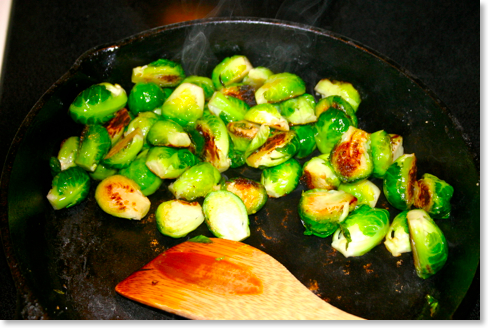
Posted by Kathy Mansfield
Vegetables? Yuck! That’s been my usual response when offered vegetables for any meal, unless they were potatoes or green beans. But, recently I’ve widened my pallet. Rick made a semi-New Year’s resolution to eat more vegetables, especially those he has never tried. Since I live here, too, that meant that I would end up having to try them, as well.
My in-laws were recently on an asparagus kick, so when we visited them earlier this year we were served this “new-to-us” vegetable several times. After we returned to Kentucky, Rick found a recipe for asparagus that we could prepare in cast iron. Although asparagus is not my favorite dish, this turn-her-nose-up-at-green-vegetables-girl has actually requested this particular asparagus recipe for dinner more than once.
PAN-GRILLED GLAZED ASPARAGUS
(adapted from "Mustard-and-Mayonnaise Glazed Asparagus" by Nate Appleman, Food & Wine, June, 2009)

Cast Iron Required:
10.25” cast iron grill pan
Ingredients
- 1/4 cup mayonnaise
- 1/4 cup coarse grain mustard
- 1/4 cup extra-virgin olive oil
- 3 tablespoons fresh lemon juice
- 1 teaspoon lemon zest, finely grated
- 1 garlic clove, crushed
- 2 teaspoons kosher salt
- 2 teaspoons freshly ground black pepper
- 1 lb. thick asparagus, trimmed
In a shallow dish, whisk the mayonnaise with the mustard, oil, lemon juice, lemon zest, garlic, salt and pepper. Add the asparagus and turn to coat. Let stand at room temperature for 30 minutes.
Heat a cast iron grill pan over a medium-high heat, turning occasionally, until the spears are tender and lightly blistered in spots—about 6 minutes. Serve the asparagus hot or at room temperature.
I was reluctant to try the next new vegetable Rick made. He announced proudly one day that he had bought brussels sprouts and had found a recipe to try with them. Nothing about that announcement sounded good to me. But, lo and behold, Rick found a way for me to like brussels sprouts—sautéed in cast iron! A key to this recipe for me is the fresh grated Parmesan cheese. I have always thought that most things taste better with cheese, and I’ve learned that most things taste better when cooked in cast iron. I put one tiny brussels sprout on my plate, knowing how disappointed Rick would be if I didn’t at least try one. It looked like a small cabbage. I closed my eyes and popped it in my mouth. I was pleasantly surprised! Who knew that I would start liking brussels sprouts at the age of 43?
GOLDEN-CRUSTED BRUSSELS SPROUTS
(adapted from the recipe by Heidi Swanson in her book Super Natural Cooking
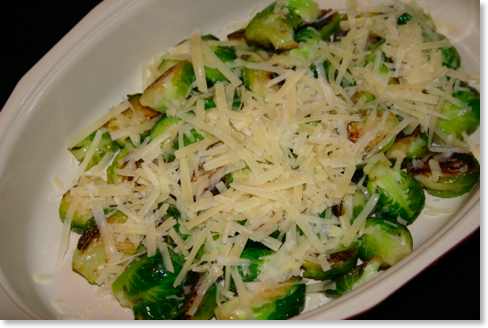
Cast Iron Required:
10.25” or 12” cast iron skillet with lid
Ingredients
- 24 small brussels sprouts
- 1 tbsp extra-virgin olive oil, plus more for rubbing
- fine grain sea salt
- black pepper, freshly ground
- 1/2 Parmesan cheese, freshly grated
Trim the stem ends of the brussels sprouts and remove any raggedy outer leaves. Cut in half from stem to top and gently rub in olive oil, keeping it intact. Heat the 1 tablespoon olive oil in a 10.25" or 12" cast iron skillet over medium heat. Don't overcook the skillet, or the outsides of the brussels sprouts will cook too quickly. Place the brussels sprouts in the skillet, flat side down, sprinkle with a couple of pinches of salt, cover and cook for about 5 minutes.
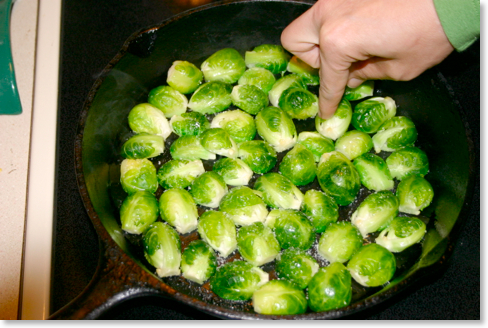
The bottoms of the sprouts should only show a hint of browning. Cut into or taste one of the sprouts to gauge whether they're tender throughout. If not, cover and cook for a few more minutes.
Once just tender, uncover, turn up the heat, and cook until the flat sides are deep brown and caramelized. use a metal spatula to toss them once or twice to get some browning on the rounded side. Use a spatula to toss them once or twice to get some browning on the rounded side. Season with more salt, a few grinds of pepper, and a dusting of grated cheese.
Best if served immediately.![]() MacGourmet users, click image to download recipe (or simply drag image to your MacGourmet recipe box).
MacGourmet users, click image to download recipe (or simply drag image to your MacGourmet recipe box).
A coupon book arrived in the mail the next week with a few recipes thrown in, one of which featured zucchini—another green vegetable I had never tried. This time I was going to take the lead and surprise Rick with my new find. The zucchini casserole was easy to make and featured fresh Parmesan. We were out, so I substituted Parmesano Regianno. Mmmm-mmmm, good!
SKILLET ZUCCHINI GRATIN
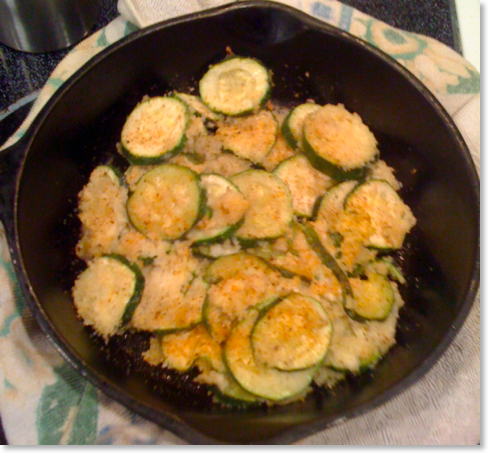
Cast Iron Required:
10 1/4” Cast Iron Skillet
Ingredients
- 5-6 medium zucchini
- 1/2 cup Parmesan cheese, shredded
- 1 cup panko bread crumbs
- 1 cup heavy cream
- 2 garlic cloves, crushed
- 3-4 sprigs fresh thyme
- olive oil
- salt and pepper, to taste
Heat cream in a small saucepan with garlic and thyme just until it starts to boil. Remove and set aside.
Slice zucchini in 1/8-inch thick rounds.
In a buttered 10.25" cast iron skillet, layer zucchini, salt, pepper, sprinkles of Parmesan cheese, panko bread crumbs, drizzles of heavy cream. Repeat layers until the pan is almost full. Finish the top with bread crumbs, Parmesan cheese and a drizzle of olive oil.
Bake at 350° for 20 to 25 minutes or until golden brown and bubbly.
I think I’m seeing a pattern here: cast iron plus cheese makes vegetables that will please!
For more of Kathy’s vegetable recipes, see her first Veggie Tales post from last year.
Feel free to leave your thoughts in the comments below, or you can contact Kathy directly at kathy@cookingincastiron.com.
Macaroni & Cheese in Cast Iron: All You Can Eat

I know I'm biased, but I really do believe that macaroni and cheese tastes better in cast iron. Most folks probably don't think about cooking dishes like this in cast iron, opting for a regular casserole dish or even a non-cast iron stove top pan if making the generic box mix from Kraft. If that's you, I have three suggestions: (1) Regardless of your recipe--whether from scratch or a mix--try it in cast iron. You will be very pleased with the texture that macaroni and cheese gets from cast iron. (2) I've yet to come across a really difficult macaroni and cheese recipes. I strongly urge you to make it from scratch rather than making it from a box. Having said that though, I realize that some folks simply like boxed macaroni and cheese. Therefore (3), if you insist on making macaroni and cheese from a box, at least try it out in cast iron--probably just a skillet--especially if you have a lid for your skillet. You will be very surprised with the results.
To test my assertion that macaroni and cheese always tastes better in cast iron, we made a number of different recipes--four to be exact--all cooked in cast iron. Some of these recipes are better than others. Since Kathy and I cooked them (and ate them!) together, she's going to add her comments. Unless you see Kathy's name next to the paragraph, assume that it's me--Rick--writing.
Supposedly, macaroni and cheese goes back to early 19th century when Thomas Jefferson served it to guests. Whether that's true or not, I don't know. What I do know is that it doesn't begin to popularly appear in cookbooks until the middle of the 20th century. Therefore in an attempt to get back to the foundations of macaroni and cheese, we started with a recipe from the original 1953 Better Homes and Garden New Cook Book
Macaroni and Cheese
1953 Better Homes and Garden New Cook Book

The recipe also calls for 2 cups of American cheese. I can't find American cheese in grocery stores these days; I can only find cheddar. I assume that I could find a block of American cheese at a specialty store, but I simply used cheddar in this recipe instead.
We used a Lodge two-quart serving pot with iron cover
Of the four macaroni and cheese dishes we made, this was the most basic and my least favorite. It's not that it was bad. Not at all. It just simply didn't stand out compared to the other three.
Kathy's comments: Although this macaroni and cheese dish was good (I can't imagine one that isn't!), it was not my favorite. The minced onions just didn't belong. I love onions, but somehow they didn't fit with this recipe. If we made this dish again, I'd try sauteed sweet onions.
Cast Iron Required:
- Two quart cast iron serving pot
- 1 6 oz. package 7-minute macaroni, (or 1 7 oz. package elbow macaroni)
- 2 cups American cheese, cubed
- 1 1/4 cups milk
- 2 tablespoons minced onion
- 1/2 teaspoon salt
- pepper
- paprika
Cook 7-minute macaroni according to directions on package. Mix with cheese, milk, onion, and salt and pepper; turn into creased two quart cast iron pot (original: 1 1/2 quart casserole). Sprinkle with paprika.
Bake mixture in moderate oven [350°] 45 minutes. Makes 6 servings.

Macaroni 'n' Cheese
1953 Better Homes and Garden New Cook Book

I used the same Lodge cast iron serving pot for this recipe as the previous one. I really liked the flavor of this version of macaroni and cheese. The onions and cream of mushroom soup give it a good flavor. It's also the only macaroni and cheese we made that was layered. It looks really nice in the serving pot once it's dipped into, and it looks simply sinful on the plate. I liked this recipe quite a bit and would like to try it again. Kathy did not care for it as much.
Kathy's comments: Of the four macaroni and cheese recipes we tried, this was my least favorite. Once again, I didn't think the onions quite belonged. Since this was the second recipe to have them as an ingredient, I assume I am simply biased against onions in my mac and cheese. I also didn't like the cream of mushroom soup. It turned this side dish into more of a casserole in its taste and feel. Don't get me wrong, I still ate plenty of it, though!
Cast Iron Required:
- Two quart serving pot
- 1 6 oz. package 7-minute macaroni
- 1 10 1/2 or 11 oz. can condensed cream of mushroom soup
- 1/2 cup milk
- 1 teaspoon grated onions
- 1/2 teaspoon salt
- dash pepper
- 1/2 pound American cheese, cubed
Cook macaroni in boiling, salted water; drain and rinse.
Combine the mushroom soup, milk, onion, and seasonings.
Alternate layers of macaroni, soup, and cheese in creased 2 quart cast iron pot (original: 1 1/2-quart baking dish). Bake in moderate oven [350°] about 45 minutes. Makes 6 servings.

Kathy's Jalapeño Macaroni and Cheese
Kathy Mansfield

Kathy's Comments: This recipe is adapted from my Mom’s delicious homemade macaroni and cheese. I live over 700 miles away from Mom, but every time I go home (usually summer and Christmas), she makes sure to have macaroni and cheese ready for me. I don’t often make the dish myself, but when I do I usually add the jalapenos for a little kick! In earlier years I used Jalapeño Cheese Whiz, but I haven’t been able to find it in my local grocery store the past few years. This dish is definitely a crowd pleaser and can even be served as a main pasta dish rather than as a side.
Cast Iron Required:
- Roaster/Casserole pan
- 1 16 oz. box macaroni noodles
- 1 8 oz. Velveeta cheese, cubed (8 oz. jar of Cheez Whiz may be substituted)
- 1-2 fresh jalapeños, chopped fine
- 1/2 stick butter
- 1 cup milk
- 2 cups grated cheddar cheese, in all
- Salt and pepper to taste
- Paprika
Cook macaroni noodles according to package directions. Butter a 9x12 cast iron baking dish. Mix noodles with Velveeta cheese, chopped jalapeños, butter, milk, and one cup of the cheddar cheese. Add salt and pepper to taste. Spread evenly in baking dish. Cover with remaining cheddar cheese. Sprinkle with paprika. Bake at 350 degrees for approximately 20 minutes, or until bubbly.
Macaroni & Cheese Supreme
Cajun Men Cook

In making it this time, we used a cup and a half of white cheddar and a cup of regular yellow cheddar. The original recipe didn't call for it, but I added a little bit of grated yellow cheddar on top for some color. With flour, butter, onions and heavy cream, this makes for one delicious recipe.
I'd also recommend having a little bit of bread handy. This recipe might leave a little bit of butter at the bottom of the bowl. A nice piece of bread can make good use of this!
Kathy's comments: Okay, okay. I know I said I was biased against onions in my mac and cheese, but in THIS recipe they are awesome! I know it's because they are sautéed first. Out of the four recipes, this was my favorite. In the past I haven't been as fond of this particular dish, but this time we used cooking wine rather than regular wine. I always thought in year's past that the wine taste was just a bit strong, but with the cooking wine, the flavor was perfect. I was sad to eat the last spoonful.
Cast Iron Required
- 10 1/4" skillet
- 1 8 oz. elbow macaroni
- 3 tablespoons butter
- 1/4 cup onion, chopped
- 3 tablespoons flour
- 1/2 teaspoon salt
- 1/8 teaspoon black pepper
- 1 cup heavy cream
- 1/2 cup white wine, (or vermouth)
- 2 1/2 cups extra sharp grated cheddar cheese
Directions:
Boil macaroni in boiling salted water according to directions. Drain. Set aside. Meanwhile melt butter, add onion, sauté till tender. Stir in flour, salt and pepper.

Slowly add cream and wine. Cook over low heat, stirring till thickened. Stir cheese until melted.

Add macaroni.

Pour into casserole dish and place in a 350° oven. Should be thoroughly heated and cheese sauce browned and bubbly—about 20 minutes.

What about you? What's your experience with macaroni and cheese in cast iron? Leave your thoughts, and if you want, your favorite recipes in the comments.
Feel free to leave your thoughts or ask questions in the comments below, or you can contact Rick directly at rick@cookingincastiron.com or Kathy at kathy@cookingincastiron.com.
Julie & Julia: A Cooking Movie Review

The screenplay, penned by director Nora Ephron, is not just the biography of Julia Child--it is mingled with a year long cooking/blogging adventure undertaken by Julie Powell in 2002. Powell challenged herself to spend a year cooking all the recipes from Julia Child’s first cookbook, Mastering The Art of French Cooking
I knew going in to the theater that I would see some semblance of a biographical tale, but I was surprised to walk out having enjoyed a romantic comedy. Meryl Streep’s Julia Child and Stanley Tucci’s Paul Child were depicted as very much in love with each other and with life. Their ability to laugh at life’s twists and turns and at Julia’s culinary mistakes made for an inspirational piece.
The dishes depicted in the movie were all real recipes from Julia Child’s cookbook, and I mentioned to Rick several times in the movie that I wanted to try particular recipes, especially the beef bourguignon. I wonder how it would taste in cast iron?
If you enjoy cooking, whether in cast iron or not, I think you’ll enjoy the delightfully charming Julie and Julia.
Rick's note: If you look closely at the pans Julia Child's character is using in the movie, in addition to her trademark copper pots, she also uses quite a few Le Creuset enameled cast iron dutch ovens.
Feel free to leave your thoughts in the comments below, or you can contact Kathy directly at kathy@cookingincastiron.com.
Review: The Cast Iron Skillet Cookbook (Part 1)
The Cast Iron Skillet Cookbook: Recipes for the Best Pan in Your Kitchen
By Sharon Kramis & Julie Kramis Hearne
2004, Sasquatch Books. ISBN 1570614253
Our household is not only filled with cast iron cookware, but also with a variety of cookbooks specifically aimed at aspiring cast iron chefs. This multi-part review will cover my experiments with six of the recipes from The Cast Iron Skillet Cookbook: Recipes for the Best Pan in Your Kitchen. The book was published in 2004 by Sasquatch Books, and it features six categories of recipes: “Breakfast & Brunch,” “Appetizers,” “Entrées,” “Sides,” “Outdoor Cookery,” and “Desserts.”
The authors, a mother/daughter duo, penned a terrific introduction that tells the history of cast iron cooking through four generations of their family, making for interesting reading. A section on how to care for cast iron is an added bonus that will serve cast iron newbies well.
Recipe #1: Monday Night Meatloaf (Entrées, p. 47)
Cast Iron Required:
• 10.25” or 12” skillet
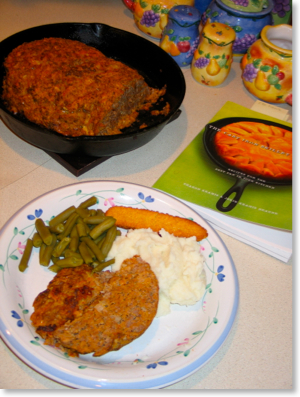
What I liked about the recipe:
- Simple ingredient list
- Very little prep work
- Pork combined with beef
- No bell peppers
What I didn’t like about the recipe:
- No glaze
- Ketchup suggested for dipping
Ingredients:
- 2 tablespoons salted butter
- 1 cup chopped yellow onion (about 1 medium-sized onion)
- 1 cup fresh bread crumbs
- 1 pound extra-lean ground beef
- 1/2 pound ground pork
- 1 can (8 ounces) tomato sauce
- 2 large eggs
- 1 cup grated cheddar cheese
- 1 teaspoon salt
- 1/2 teaspoon freshly ground black pepper
- 2 teaspoons dried Italian herb seasoning
- Ketchup, for serving
Directions:
Position a rack in the center of the oven and preheat to 350°
In a 10- or 12-inch cast iron skillet, melt the butter over medium heat. Stir in the chopped onion and cook for 3 minutes.

Transfer to a large mixing bowl. Place all of the remaining ingredients in the bowl with the onions, and mix together with your hands until well blended.

Form into a football-shaped loaf in the same skillet in which you cooked the onions.

Place the skillet in the oven and bake until the center is no longer pink, about 1 hour. Let cool for 10 minutes.

Pour off the excess fat and juices. Slice and serve hot, with ketchup for dipping [we opted not to use Ketchup, although Rick used Country Bob’s on his second helping].![]() MacGourmet users, click image to download recipe (or simply drag image to your MacGourmet recipe box).
MacGourmet users, click image to download recipe (or simply drag image to your MacGourmet recipe box).
Recipe #2: Horseradish Mashed Potatoes (“Entrées,” p. 51)
This recipe, although listed in the cookbook, is not a featured dish. It is listed as an “accompaniment” to the “Braised Spareribs in Merlot Sauce” (p. 50-51) I plan to make that dish for a later review, but I wanted some sort of mashed potato side for the meatloaf, so I chose to use it this time, too. It does not use cast iron cookware, however.
Ingredients:
- 2 pounds russet or Yukon Gold potatoes, peeled and quartered
- 1/2 teaspoon salt, plus more for seasoning
- 6 tablespoons heavy cream or half-and-half3 tablespoons unsalted butter
- 3 tablespoons mascarpone or sour cream
- 1 tablespoon creamy horseradish
- Freshly ground black pepper
Directions:
Place the potatoes in a large stockpot with the 1/2 teaspoon salt and enough water to cover.
Bring to a rapid boil over high heat. Reduce the heat to medium and cook until soft: drain. Return the potatoes to the pot and cook over medium heat for 3 to 5 minutes, allowing them to absorb some of the moisture. Reduce the heat to low and shake the potatoes over the heat for 3 minutes. Mash with a potato ricer, using medium-wide holes.
In a small saucepan over low heat, mix together the cream, butter, mascarpone, and horseradish. Cook for 5 minutes. Be careful not to let this mixture come to a boil.
Slowly pour the cream mixture into the potatoes while whipping the potatoes with a fork or a whisk. Mix until light and fluffy. Season to taste with salt and pepper and serve hot.
Final Results:

Wow! This meatloaf is definitely a keeper! And, although Rick was wary of the horseradish potatoes, he was pleasantly surprised. I look forward to trying more dishes during the next few weeks. Look for reviews of “Braised Spareribs in Merlot Sauce,” “Slow-Roasted Beef Brisket with Apple Cider-Ginger Barbecue Sauce and Caramelized Sweet Onions,” “Herbed Skillet Bread,” and “Brown Sugar Coffee Cake.” I can’t wait!
You can also follow one of The Cast Iron Skillet’s co-writers, Julie Kramis Hearne on her website, blog and on Twitter.
Feel free to leave your thoughts in the comments below, or you can contact Kathy directly at kathy@cookingincastiron.com.
Veggie Tales
Like most kids, I despised vegetables. In fact, I recall living solely on Spaghetti-O’s for a good portion of my growing up years. So, the fact that I will even go near vegetables as an adult is a minor miracle. All this to say, the following cast-iron vegetable dishes must be fairly tasty if I’m willing to put them on my plate. I hope you will enjoy them, too.
Mom’s Squash and Onion Sauté
Mom used to make this dish when I was younger, and I thought it looked absolutely disgusting, so naturally I refused to eat it. At some point in my thirties, I attempted the dish on my own with slight variations (sweetened, caramelized onions, etc.) and found a new favorite. Now Mom actually prefers my recipe!
CAST IRON REQUIRED
• 10 1/4” cast iron skillet
INGREDIENTS
- 4 large yellow squash, peeled and sliced fairly thin
- 1 medium Vidalia onion, sliced
- 1 Tablespoon olive oil
- 1 Tablespoon sugar or artificial sweetener
- Salt to taste
DIRECTIONS
Heat oil in 10 1/4 inch cast iron skillet. Sautee onions until almost caramelized.

Place squash slices on top of onions.

Cover and cook approximately 15 minutes over medium low heat, stirring occasionally to rotate onions to top of pile. Sprinkle sugar (artificial sweeteners such as Splenda work fine, too) after the squash has softened a bit. Add salt to taste. Cook until desired consistency.

(As you can tell from the pictures, I prefer mine cooked down quite a bit). Mmm, mmm, good!
Wendy’s Quick Green Beans w/ Shallots
My good friend Wendy Smith made this vegetable side for a meal while we were visiting in her home. As with the squash above, I’ve adapted the recipe to a more Southern-style “cooked until soggy” consistency rather than the healthier crunch to the vegetables and added good ole Southern-style non-healthy bacon (leave out the bacon for the healthier version).
CAST IRON REQUIRED
• 10 1/4” cast iron skillet
INGREDIENTS
- 1 package frozen green beans (small or medium bag)
- 1 shallot, chopped
- 1 slice bacon, cut into tiny pieces
- 1 Tablespoon olive oil
- 1 Tablespoon sugar or artificial sweetener
- Salt to taste
Heat oil in 10 1/4 inch cast iron skillet for medium bag of beans or 7 inch cast iron skillet for small bag of beans. Sautee chopped shallot and bacon bits until bacon is not quite crisp and shallot is almost opaque.

Add frozen green beans.

Cover and cook over medium low heat until beans are heated through. Sprinkle with sugar (I use Splenda).

Add salt to taste. As with the squash dish above, I tend to cook the beans to a nice, soggy consistency

Feel free to leave your thoughts in the comments below, or you can contact Kathy directly at kathy@cookingincastiron.com.
Is It the Cast Iron or the Cook?
Rick is a little too humble to post this, but I have no qualms bragging on what a wonderful cook he is! For the third consecutive year, Rick has been named Chili Cook-Off Grand Prize Winner at the annual Simpsonville Baptist Church Family Football Night (because they can’t call it a Super Bowl Party!) and Chili Cook-Off. I’m a pretty finicky eater, and even more so about any tomato-based recipe, so when I say Rick makes good chili, I mean it. And, I suppose, enough other folks agree, too, since he is a three time champ in our little hometown. But, is it truly the cook? Or might it be the new enameled cast iron Dutch oven

Rick makes what he calls his “Louisiana Chili.” The “Louisiana” part comes from his use of Andouille sausage as one of the ingredients. The actual recipe is some deep, dark secret, so you won’t see it posted here. So that’s the Cook part of what makes the chili so good. The Cast Iron contribution is the new enameled Dutch oven Rick used this year. Tomato-based recipes can wreak havoc on cast iron, but the enameled pieces sold by Lodge are the perfect answer when you want the consistency and feel of cast iron without the damage to your well-seasoned cookware.

Enjoy the pictures, but don’t look for the super secret recipe anytime soon!

Feel free to leave your thoughts in the comments below, or you can contact Kathy directly at kathy@cookingincastiron.com.
Review: RangeKleen 12" Deep Fryer

Kathy: We don’t actually have a deep fryer, and when we occasionally do fry something, I have to use either one of our cast iron skillets (which isn’t deep enough) or a dutch oven (which can sometimes be too deep). I was immediately drawn to the RangeKleen deep fryer, and could think of nothing better for it’s initial use than to fry chicken in the same manner that my mother taught me years ago.
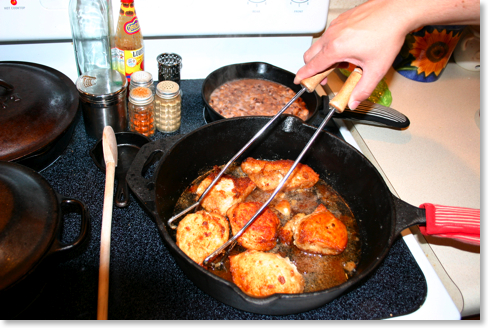
Turning the chicken with tongs helps to hold in the juices.
Rick made delicious milk gravy for the rice. (I have no clue how to make gravy!)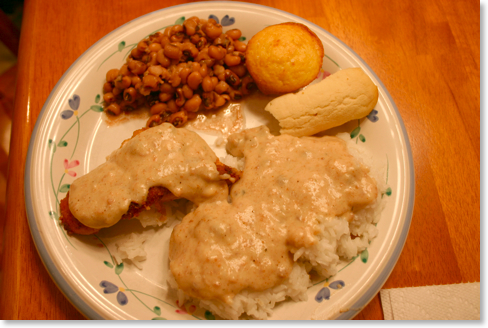
The final meal: Fried chicken, rice, milk gravy, black-eyed peas, cornbread. Yum!
I really liked the heaviness of this skillet. I don’t want to have to hold the handle while I stir things or move food around, and this skillet was just the right weight to allow me to concentrate on the food, not the cookware. The deep sides also allowed me to fry in more oil than what I would in a shallow skillet. This made the chicken much more crispy -- just like it should be!
Rick: Since Kathy used the deep fryer for it’s normal intended use, I decided to do something different. I love the little cast iron cookbook, A Skillet Full

Sautéing the onions, celery and bell pepper in butter.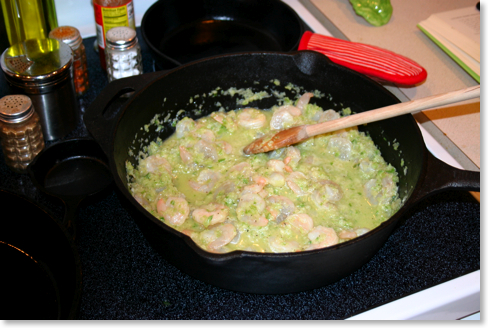
Adding in the shrimp.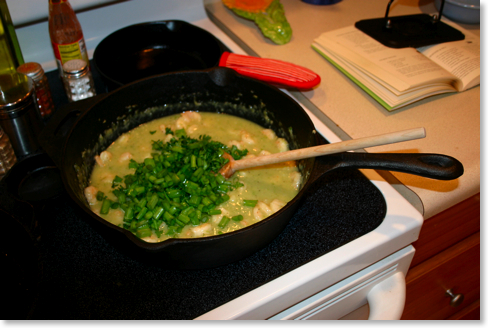
Adding in the green onions and parsley 
Essentially the final product. Note height of residue on the sides from stirring.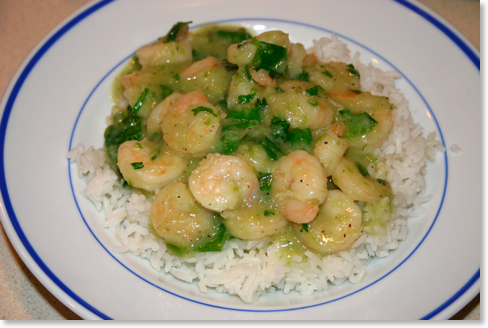
Seafood and Rice in the bowl.
I discovered something similar to what Kathy had enjoyed about the RangeKleen deep fryer: it’s weight kept my left hand free from the handle as I often have to do with a regular skillet. But my real question had to do with the need for a deep fryer to begin with. Although the ingredients would have easily fit into a traditional 10 1/4” cast iron skillet, the advantage of the deep fryer came in the stirring, which I had to do frequently for this recipe. As you can see two pictures up, I needed that extra inch or two for all the stirring. Although this recipe could be done in a regular skillet, it is easier to cook it in a deep fryer such as this one from RangeKleen. Incidentally, the lid to my Lodge 7 qt dutch oven fit the RangeKleen deep fryer perfectly.
JT: For the price, cast iron’s versatility is unmatched in my estimation. The RangeKleen 12” Deep Fryer, like most cast iron cookware works in the oven as well as on the stovetop. We used the RangeKleen pan in the oven for several baked items, and while the pan functions well, the diameter was too large for cakes and bread puddings. The combined ingredients spread out too far making the baked item too thin, and for bread pudding the liquid portion spreads too low allowing the bread to sit too high. This is more a use of the wrong tool for the wrong application than a problem with the pan. For other applications, like potatoes, or sautéing vegetables then finishing them in the oven, the pan will work extremely well.
One of the comfort elements was evident when picking up the pan for the first time. The handle is rounded more than most pans, so there is less edge pressure on the users hand when gripping the handle. This is especially beneficial considering the size and weight of the pan.
From an esthetic standpoint the pan has a rougher texture than most pans, which may be a result of the sand mould used to cast the pan. This doesn’t impact the cooking function of the pan, but does effect the clean up and appearance.
Below are pictures of two variations of bread pudding that JT’s wife, Jenn, made in the RangeKleen Deep Fryer:
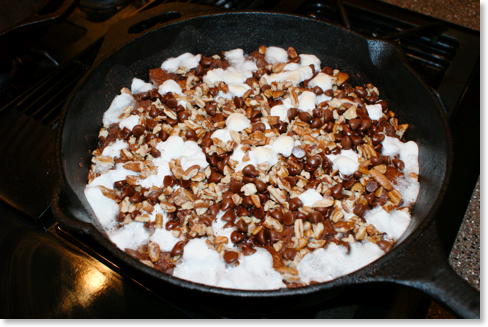
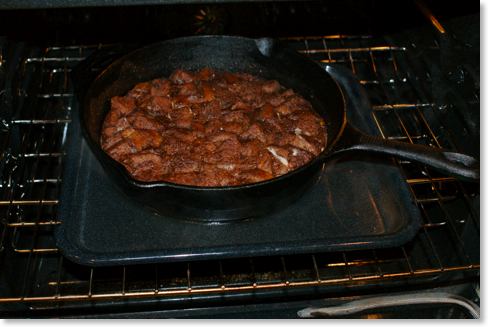
A Final Note: [Rick writing here]-- Accompanying the RangeKleen 12” Deep Fryer was a warning not to use it on smooth top ranges. Kathy and I currently have a smooth top range (much to our chagrin), but we decided to use the fryer anyway. The reason for the warning is obvious upon holding the pan: it is heavy and the exterior a bit rough as JT noted above. It could easily put scratches on a flat surface stovetop if it was moved around a good bit. We were both very careful not to move it. And it’s weight kept it from easily being jostled.
Unfortunately, by the time we finally posted this review, this particular pan is no longer in production. But you can find the current RangeKleen selection of cast iron frying pans and dutch ovens at their website.
Click here for all pictures taken of the RangeKleen 12” Deep Fryer in action.
Your comments and questions, as always are welcome.
Showing Off the Iron
Where, oh where, do I store all of this cast iron? That is certainly the question that has plagued our household over the past year. We’ve owned various cast iron pieces over the past years, but after a trip to the Lodge Store in South Pittsburgh, Tennessee, we faced the dilemma of where to put the 17 new pieces of cast iron!

Rick and I already had a wrought iron baker’s rack from Ashley Furniture that showcased our cookbook collection, so we decided a matching baker’s rack would be the perfect partner piece to display our cast iron cookware. Although some assembly was required (by Rick, not me!), we are quite pleased with our new means of highlighting our cast iron in our home.

As you can see in the pictures, our heaviest pieces (dutch ovens) are on the bottom rack. We have smaller pieces such as fajita pans and loaf pans on the middle two shelves. The top shelf is reserved for cookbooks specific to cast iron aficionados. I was even able to find wrought iron book holders at Wal-Mart to help spotlight our favorite cookbooks.

Will another baker’s rack be in our future? Well, one more trip to Lodge just might do it!

Feel free to leave your thoughts in the comments below, or you can contact Kathy directly at kathy@cookingincastiron.com.
Cast Iron Accessories



No, I don't sell Pampered Chef, but I sure am pleased with the great products I've discovered through that company to help keep our cast iron looking fabulous in every season!
Feel free to leave your thoughts in the comments below, or you can contact Kathy directly at kathy@cookingincastiron.com.






